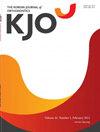连续后弯弓丝与上颌间弹性矫治ⅱ类错颌的牙体运动三维分析
IF 1.9
3区 医学
Q1 Dentistry
引用次数: 2
摘要
目的通过叠加三维虚拟模型,分析连续后弯或补偿曲线弓丝配合上颌间弹性矫治II类错牙列的三维变化。方法选取20例患者,其中男2例,女18例;平均年龄20岁7个月±3岁9个月),采用0.016 × 0.022英寸带连续后弯的多环形弓丝或带补偿曲线的钛钼合金理想弓丝,并配合上颌骨间弹性材料治疗II类错颌。采用Rapidform 2006软件对治疗前后的三维虚拟模型进行线性和角度测量,并采用配对t检验对结果进行分析。结果上颌牙后移位(p < 0.01)伴犬齿、第二前磨牙和第一磨牙远端冠倾(p < 0.05),上颌弓扩张(p < 0.05)伴第二前磨牙和第一磨牙反转(p < 0.01),第一磨牙远端内旋(p < 0.01)。前后牙合平面角差减小(p < 0.001),前牙挤压(p < 0.05),第二前磨牙和第一磨牙挤压(p < 0.001)。结论第二类治疗采用连续后弯弓丝或补偿弯曲弓丝配合上颌间弹性材料,可使上颌牙列收缩扩大,并可减小咬合弯曲。这些结果将有助于临床医生理解这种II类治疗的机制。本文章由计算机程序翻译,如有差异,请以英文原文为准。
Three-dimensional analysis of tooth movement in Class II malocclusion treatment using arch wire with continuous tip-back bends and intermaxillary elastics
Objective The aim of this study was to analyze three-dimensional (3D) changes in maxillary dentition in Class II malocclusion treatment using arch wire with continuous tip-back bends or compensating curve, together with intermaxillary elastics by superimposing 3D virtual models. Methods The subjects were 20 patients (2 men and 18 women; mean age 20 years 7 months ± 3 years 9 months) with Class II malocclusion treated using 0.016 × 0.022-inch multiloop edgewise arch wire with continuous tip-back bends or titanium molybdenum alloy ideal arch wire with compensating curve, together with intermaxillary elastics. Linear and angular measurements were performed to investigate maxillary teeth displacement by superimposing pre- and post-treatment 3D virtual models using Rapidform 2006 and analyzing the results using paired t-tests. Results There were posterior displacement of maxillary teeth (p < 0.01) with distal crown tipping of canine, second premolar and first molar (p < 0.05), expansion of maxillary arch (p < 0.05) with buccoversion of second premolar and first molar (p < 0.01), and distal-in rotation of first molar (p < 0.01). Reduced angular difference between anterior and posterior occlusal planes (p < 0.001), with extrusion of anterior teeth (p < 0.05) and intrusion of second premolar and first molar (p < 0.001) was observed. Conclusions Class II treatment using an arch wire with continuous tip-back bends or a compensating curve, together with intermaxillary elastics, could retract and expand maxillary dentition, and reduce occlusal curvature. These results will help clinicians in understanding the mechanism of this Class II treatment.
求助全文
通过发布文献求助,成功后即可免费获取论文全文。
去求助
来源期刊

Korean Journal of Orthodontics
Dentistry-Orthodontics
CiteScore
2.60
自引率
10.50%
发文量
48
审稿时长
3 months
期刊介绍:
The Korean Journal of Orthodontics (KJO) is an international, open access, peer reviewed journal published in January, March, May, July, September, and November each year. It was first launched in 1970 and, as the official scientific publication of Korean Association of Orthodontists, KJO aims to publish high quality clinical and scientific original research papers in all areas related to orthodontics and dentofacial orthopedics. Specifically, its interest focuses on evidence-based investigations of contemporary diagnostic procedures and treatment techniques, expanding to significant clinical reports of diverse treatment approaches.
The scope of KJO covers all areas of orthodontics and dentofacial orthopedics including successful diagnostic procedures and treatment planning, growth and development of the face and its clinical implications, appliance designs, biomechanics, TMJ disorders and adult treatment. Specifically, its latest interest focuses on skeletal anchorage devices, orthodontic appliance and biomaterials, 3 dimensional imaging techniques utilized for dentofacial diagnosis and treatment planning, and orthognathic surgery to correct skeletal disharmony in association of orthodontic treatment.
 求助内容:
求助内容: 应助结果提醒方式:
应助结果提醒方式:


